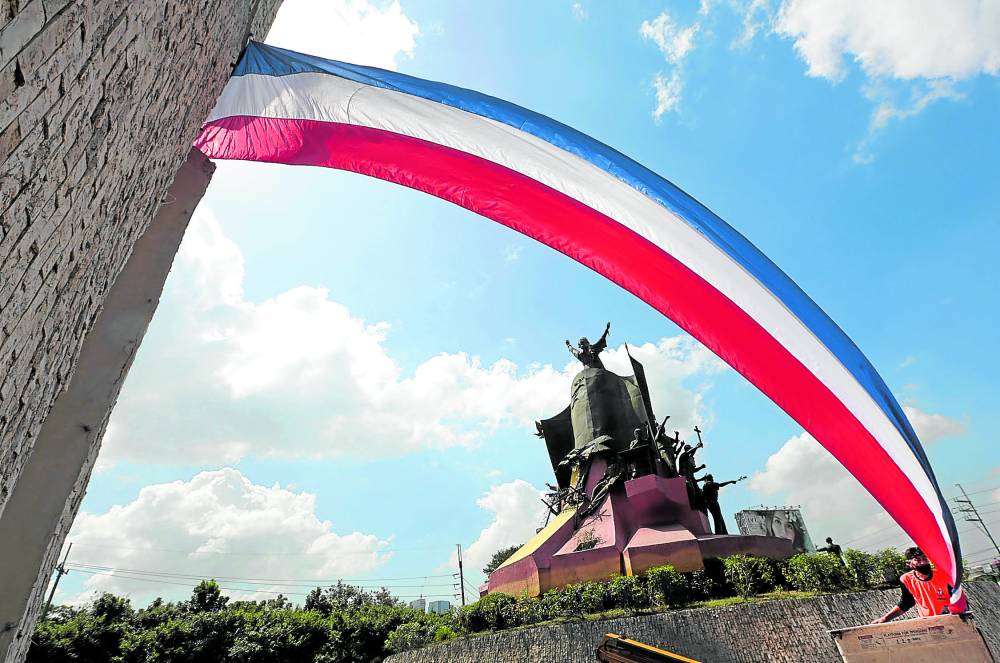
REVOLUTION LANDMARK Workers of the Department of Public Works and Highways spruce up the People Power Monument, the 1986 revolution landmark on Edsa in Quezon City, for 36th anniversary celebration of the ouster of dictator Ferdinand Marcos. —GRIG C. MONTEGRANDE
Filipinos should never forget how the 1986 Edsa People Power Revolution inspired citizens in other countries to demand change or end repressive regimes without bloodshed, said Carmelo Victor Crisanto, one of the civil society leaders who on Friday commemorated the 36th anniversary of the largely peaceful uprising that toppled the Marcos dictatorship.
Crisanto, executive director of Human Rights Violations Victims’ Memorial Commission (HRVVMC), noted that today’s youth had not been fully educated about the horrors of martial law under Marcos, and yet the event that ended this dark period had spawned similar prodemocracy movements abroad.
Posthumous honors
“The Philippines started that. This is a badge of courage,” he said on the sidelines of #DanceForTruth 2022, an event organized by the HRVVMC and Survivors’ Hub, a group of martial law survivors, at the Bantayog ng mga Bayani in Quezon City. “I wish I could just share this pride of how lucky I am to be a Filipino.”
He cited, among the more recent examples, the 2014 ‘’Umbrella Movement’’ in Hong Kong against China’s decision to rule out full universal suffrage in the territory, and the 2018 Yellow Vests protests in France.
As part of the Edsa rites, the foundation also conferred posthumous recognition on Nicetas Perez, a student journalist who joined the political underground during martial law and was killed by the Philippine Constabulary (PC) and Citizens Home Defense Force in Guinayangan, Quezon province, on Oct. 6, 1976.
A plaque honoring Perez was presented to his younger sister, Dominga Perez-Tuazon.
The citation recalled that before he was killed by the PC in an encounter, Perez was detained and tortured at Camp Vicente in Canlubang, Laguna province, and later pulled off a “heroic escape” in late 1972.
Church, Palace messages
Also on Friday, in his homily at Edsa Shrine, Manila Archbishop Cardinal Jose Advincula reminded the faithful that Edsa “is not just a political event about the reconfiguration of power, but a spiritual and religious event that cuts through time.”
“Let us transcend our selfish preferences and personal conveniences for the sake of the common good. Let us be agents and instruments of truth, charity and righteousness in our beloved Philippines,” Advincula said.
In his anniversary message, President Duterte called on Filto honor the people who keep Edsa’s legacy alive.
“This celebration serves as a strong reminder that with unity, cooperation and faith, there is nothing that we cannot collectively achieve for the greater good of our country,” Mr. Duterte said.
“As we honor the courage and solidarity of those who have come before us and fought to uphold our democracy, let us also honor and thank those who continue to keep alive the legacy of this largely peaceful and nonviolent revolution,” he said.
These include the honest and effective public servants, those who conduct rescue and relief operations during calamities, community volunteers, and medical and essential front-liners during the COVID-19 pandemic, he said.
As in previous years, Mr. Duterte—who in November 2016 allowed the dictator’s remains to be given a hero’s burial at Libingan ng mga Bayani did not appear in any public event marking the February 1986 upheaval.
No yellows
At the People Power Monument, the government venue for commemoration, Interior Secretary Eduardo Año led the program which only lasted about 10 minutes. It included the flag ceremony, wreath-laying rites and the playing of the Edsa hymn “Handog ng Pilipino sa Mundo.”
Año and other guests closed the program waving Philippine flags under a shower of red, white and blue confetti—with none of the yellow motif that dominated previous anniversaries.
“Edsa revolution is all about achieving change through peaceful means. It shows that the Filipino people can resolve a conflict through peaceful means if there is unity among us. We should probably use that experience in resolving future conflicts and issues in the country,” Año told reporters after the program.
After the government delegation left, the monument next became the site of a ‘’grand teach-in’’ conducted by anti-Marcos activists from the groups Akademiya at Bayan Kontra Disimpormasyon at Dayaan, Movement Against Tyranny, and Campaign Against the Return of the Marcoses and Martial Law.
What if . . .
A lineup of speakers—representing martial law victims, educators, workers, peasants, economists and lawyers—took turns addressing the crowd estimated at 4,000.
Comedian Willie Nepomuceno, famous for mimicking politicians, reprised his impersonation of Ferdinand Marcos, while activist Mae Paner played Imelda Marcos.
“This cannot be the last Edsa,” said Renato Reyes Jr., secretary general of Bagong Alyansang Makabayan, alluding to concerns about the future of Edsa-related events should the late dictator’s son and namesake, a consistent frontrunner in pre-election surveys, win the May 9 presidential race.
“Edsa People Power is not just an official celebration. It is in the hearts of people. We are Edsa, so it will not be gone, even if there [were] no more official commemorations. We will not let the people forget about Edsa,” he added. —With a report from Leila B. Salaverria